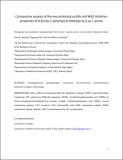Comparative analysis of the neurochemical profile and MAO inhibition properties of N-(furan-2-ylmethyl)-N-methylprop-2-yn-1-amine
Abstract
The regulation of brain monoamine levels is paramount for cognitive functions and the enzymes monoamine oxidases (MAO A and B) play a central role in these processes. The aim of this study was to evaluate whether the pro-cognitive properties exerted by propargylamine N-(furan-2-ylmethyl)-N-methylprop-2-yn-1-amine (F2MPA) were related to changes in monoamine content via MAO inhibition. In vivo microdialysis and ex vivo amine metabolite measurement demonstrated region-specific alterations in monoamine metabolism that differ from both the classic MAO A or MAO B inhibitors clorgyline and L-deprenyl, respectively. Although all the inhibitors (1 and 4 mg/kg) increased cortical serotonin tissue content, only F2MPA increased the levels of cortical noradrenaline. In the striatum, clorgyline (1 mg/kg), but not F2MPA (1 mg/kg), reduced extracellular levels of dopamine metabolites at rest or stimulated by the intrastriatal application of the MAO substrate 3-methoxytyramin. In vitro, F2MPA exhibited a low affinity toward MAO B and MAO A. Nonetheless, it modified the B form of MAO, forming a flavin adduct structurally similar to that with deprenyl. F2MPA was rapidly metabolized in the presence of rat, but not human, microsomes, producing a hydroxylated derivative. In conclusion, the effect of F2MPA on cognition may arise from monoaminergic changes in the cortex, but the role of MAO in this process is likely to be negligible, consistently to the F2MPA poor affinity for MAO.
Citation
De Deurwaerdère , P , Binda , C , Corne , R , Leone , C , Valeri , A , Valoti , M , Ramsay , R R , Fall , Y & Marco-Contelles , J 2017 , ' Comparative analysis of the neurochemical profile and MAO inhibition properties of N -(furan-2-ylmethyl)- N -methylprop-2-yn-1-amine ' , ACS Chemical Neuroscience , vol. 8 , no. 5 , cn-2016-00377h , pp. 1026-1035 . https://doi.org/10.1021/acschemneuro.6b00377
Publication
ACS Chemical Neuroscience
Status
Peer reviewed
ISSN
1948-7193Type
Journal article
Description
Collaborations among authors were enabled by COST Action CM1103, Structure-based drug design for diagnosis and treatment of neurological diseases.Collections
Items in the St Andrews Research Repository are protected by copyright, with all rights reserved, unless otherwise indicated.

